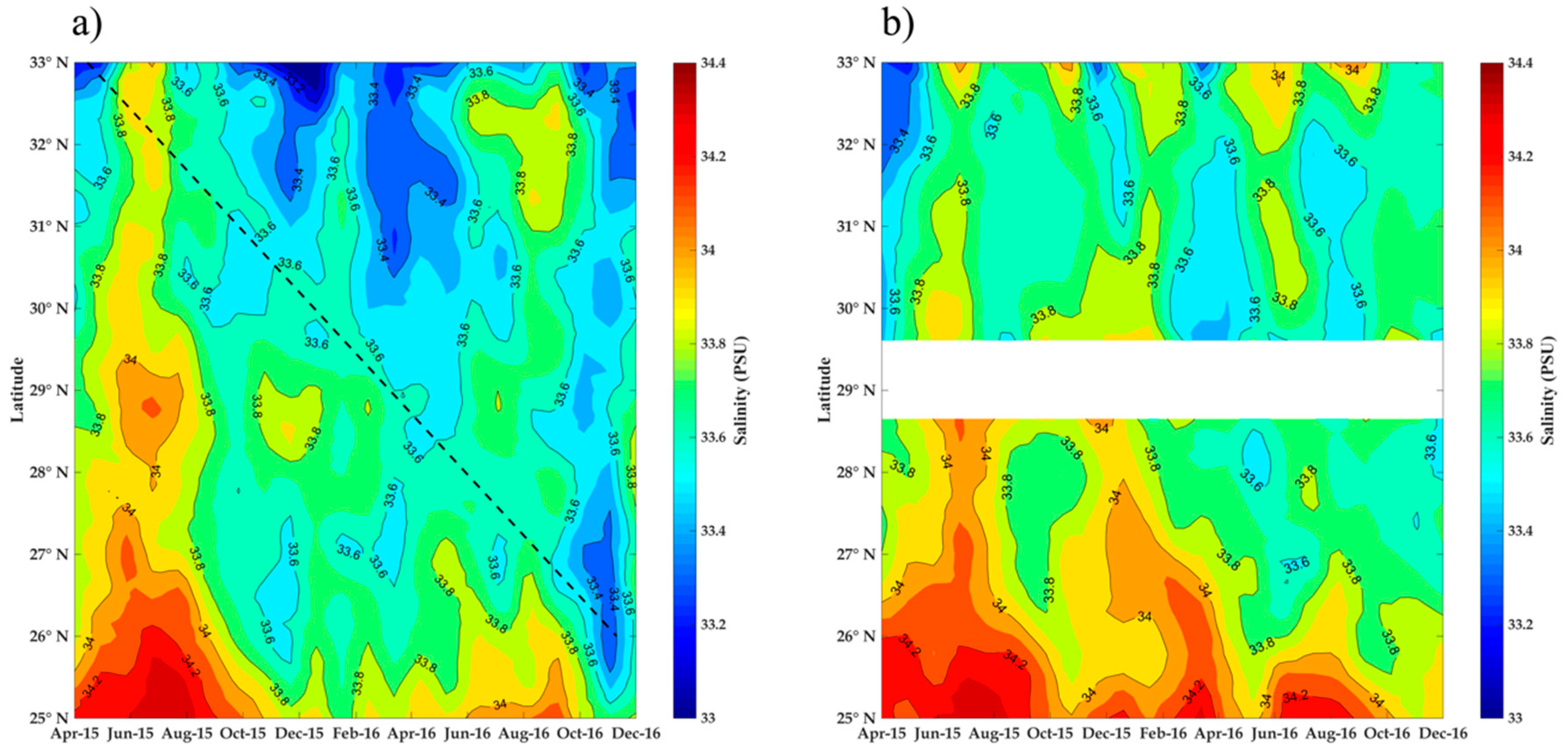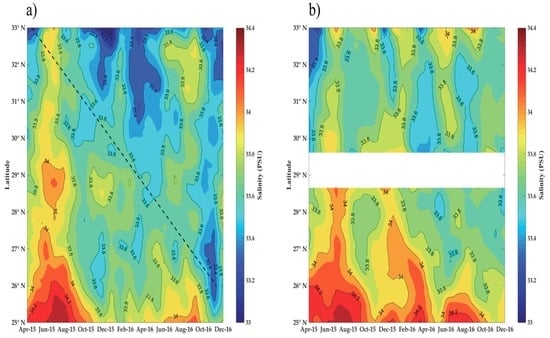SMAP and CalCOFI Observe Freshening during the 2014–2016 Northeast Pacific Warm Anomaly
Abstract
:1. Introduction
2. Materials and Methods
2.1. Methods
- (1)
- Examination of the space-time variability of SSS from SMAP using Hovmöller diagrams.
- (2)
- Validation of SMAP SSS by direct comparisons with CalCOFI-derived salinity at a one-meter depth.
- (3)
- Evaluation of the space-time variability of salinity and stratification parameters associated with the warming event using CalCOFI data.
- (4)
- Evaluation of SMAP SSS versus CalCOFI salinity differences based on air-sea interaction.
2.2. Data
2.2.1. JPL SMAP Data
2.2.2. CalCOFI Data
2.2.3. Evaporation Data
2.2.4. Precipitation Data
3. Results
3.1. Evaluation of SMAP Data
3.2. Salinity Variations Induced by Precipitation and Evaporation
3.3. CalCOFI Observations
4. Discussion
5. Conclusions
Supplementary Materials
Supplementary File 1Author Contributions
Funding
Acknowledgments
Conflicts of Interest
References
- Gentemann, C.L.; Fewings, M.L.; Garcia-Reyes, M. Satellite sea surface temperature along the West Coast of the United States during the 2014–2016 northeast Pacific marine heat wave. Geophys. Res. Lett. 2016, 44, 312–319. [Google Scholar] [CrossRef]
- Ryan, J.P.; Kudela, R.M.; Birch, J.M.; Blum, M.; Bowers, H.A.; Chavez, F.P.; Doucette, G.J.; Hayashi, K.; Marin, R., III; Mikulski, C.M.; Pennington, J.T.; et al. Causality of an extreme harmful algal bloom in Monterey Ba, California, during the 2014-2016 northeast Pacific warm anomaly. Geophys. Res. Lett. 2017, 44, 5571–5579. [Google Scholar] [CrossRef]
- Peterson, W.T.; Fisher, J.L.; Strub, P.T.; Du, X.; Risien, C.; Peterson, J.; Shaw, C.T. The pelagic ecosystem in the Northern California Current off Oregon during the 2014-2016 warm anomalies within the context of the past 20 years. J. Geophys. Res. Oceans 2017, 122. [Google Scholar] [CrossRef]
- Zaba, K.D.; Rudnick, D.L. The 2014–2015 warming anomaly in the Southern California Current System observed by underwater gliders. Geophys. Res. Lett. 2016, 43, 1241–1248. [Google Scholar] [CrossRef]
- Jacox, M.G.; Hazen, E.L.; Zaba, K.D.; Rudnick, D.L.; Edwards, C.A.; Moore, A.M.; Bograd, S.J. Impacts of the 2015–2016 El Niño on the California Current System. Early assessment and comparison to past events. Geophys. Res. Lett. 2006, 43, 7072–7080. [Google Scholar] [CrossRef]
- Fournier, S.; Reager, J.T.; Lee, T.; Vazquez-Cuervo, J.; David, C.H.; Gierach, M.M. SMAP observes flooding from land to sea: The Texas event of 2015. Geophys. Res. Lett. 2016, 43. [Google Scholar] [CrossRef]
- Pares-Escobar, F.; Lavaniegos, B.E.; Ambriz-Arreola, I. Interannual variability in oceanic euphausiid communities off the Baja California western coast during 1998–2008. Progr. Oceanogr. 2018, 160, 53–67. [Google Scholar] [CrossRef]
- Boutin, J.; Chao, Y.; Asher, W.E.; Delcroix, T.; Drucker, R.; Drushka, K.; Kolodziejczyk, N.; Lee, T.; Reul, N.; Reverdin, G.; et al. Satellite and in situ salinity: Understanding near-surface stratification and sub-footprint variability. Bull. Am. Meteorol. Soc. 2016. [Google Scholar] [CrossRef]
- Leising, A.W.; Schroeder, I.D.; Bograd, S.J.; Abell, J.; Durazo, R.; Gaxiola-Castro, G.; Bjorkstedt, E.P.; Field, J.; Sakuma, K.; Robertson, R.R.; et al. State of the California Current 2014–15: Impacts of the warm-water “blob”. Calif. Coop. Fish. Investig. Rep. 2015, 56, 31–68. [Google Scholar]
- McClatchie, S.; Goericke, R.; Leising, A.; Auth, T.D.; Bjorkstedt, E.; Robertson, R.R.; Brodeur, R.D.; Du, X.; Daly, E.A.; Morgan, C.A.; et al. State of the California Current 2015–2016: Comparisons with the 1997–98 El Niño. Calif. Coop. Fish. Investig. Rep. 2016, 57, 5–61. [Google Scholar]
- Wells, B.K.; Schroeder, I.D.; Bograd, S.J.; Hazen, E.L.; Jacox, M.G.; Leising, A.; Mantua, N.; Santora, J.A.; Fisher, J.; Peterson, W.T.; et al. State of the California Current 2016–17: Still anything but “normal” in the north. Calif. Coop. Fish. Investig. Rep. 2017, 58, 1–55. [Google Scholar]
- McClain, C.R. A decade of satellite ocean color observations. Annu. Rev. Mar. Sci. 2008, 1, 19–42. [Google Scholar] [CrossRef] [PubMed]
- Sato, O.T.; Polito, P.S.; Liu, W.T. Importance of salinity measurement in the heat storage estimation from TOPEX/POSEIDON. Geophys. Res. Lett. 2000, 27, 549–551. [Google Scholar] [CrossRef]
- Bograd, S.J.; Lynn, R.J. Long-term variability in the Southern California Current System. Deep-Sea Res. II 2003, 50, 2355–2370. [Google Scholar] [CrossRef]
- Garcia-Reyes, M.; Largier, J.L. Seasonality of coastal upwelling off central and northern California: New insights, including temporal and spatial variability. J. Geophys. Res. 2012, 117, C03028. [Google Scholar] [CrossRef]
- Torres, H.S.; Gomez-Valdes, J. Coastal Circulation driven by short-period upwelling-favorable winds in the northern Baja California region. Deep-Sea Res. I 2015, 98, 31–42. [Google Scholar] [CrossRef]
- Feng, M.; Hacker, P.; Lukas, R. Upper ocean heat and salt balances in response to a westerly wind burst in the western equatorial Pacific during TOGA COARE. J. Geophys. Res. 1998, 103, 10289–10311. [Google Scholar] [CrossRef] [Green Version]
- Fore, A.; Yueh, S.; Tang, W.; Hayashi, A. SMAP Salinity and Wind Speed Data User’s Guide; version 3; Jet Propulsion Laboratory/California Institute of Technology: Pasadena, CA, USA, 2016.
- Yu, L.; Jin, X.; Weller, R.A. Multidecadal Global Flux Datasets from the. Objectively Analyzed Air-sea Fluxes (OAFlux) Project: Latent and Sensible Heat Fluxes,. Ocean Evaporation, and Related Surface Meteorological Variables (OAFlux Project Technical Report OA-2008-01); Woods Hole Oceanographic Institution: Woods Hole, MA, USA, 2008; p. 64. [Google Scholar]
- Wentz, F.J. SSM/I Version-7 Calibration Report; RSS Technical Report 011012; Remote Sensing Systems: Santa Rosa, CA, USA, 2013; p. 46. [Google Scholar]
- Schwing, F.B.; O’Farrell, M.; Steger, J.M.; Baltz, K. Coastal Upwelling Indices West Coast of North America 1946-95; NOAA Technical Memorandum, NMFS, NOAA-TM-NMFS-SWFSC-231; United States Department of Commerce: Washington, DC, USA, 1996.
- Gómez-Ocampo, E.; Gaxiola-Castro, G.; Durazo, R.; Beier, E. Effects of the 2013–2016 warm anomalies on the California Current Phytoplankton. Deep-Sea Res. II 2017. [Google Scholar] [CrossRef]
- Di Lorenzo, E.; Mantua, N. Multi-year persistence of the 2014/15 North Pacific marine heat wave. Nat. Clim. Chang. 2016, 6. [Google Scholar] [CrossRef]
- Tang, W.; Fore, A.; Yueh, S.; Lee, T.; Hayashi, A.; Sanchez-Franks, A.; Martinez, J.; King, B.; Baranowski, D. Validating SMAP SSS with in situ measurements. Remote Sens. Environ. 2017, 200, 326–340. [Google Scholar] [CrossRef]
- Meissner, T.; Wentz, F.J.; Scott, J.; Vazquez-Cuervo, J. Sensitivity of Ocean Surface Salinity Measurements from Spaceborne L-Band Radiometers to Ancillary Sea Surface Temperature. IEEE Trans. Geosci. Remote Sens. 2016, 54, 7105–7111. [Google Scholar] [CrossRef]








| Month | 2015–2016 (Units Are PSU) |
|---|---|
| January | −1.3 |
| April | −0.6 |
| July | 0.1 |
| November | −2.2 |
| Year | Range | Median | Skewness | Kurtosis |
|---|---|---|---|---|
| 2013 | 33.2–33.9 | 33.6 | −0.5 | 4.9 |
| 2014 | 33.2–33.6 | 33.5 | −1.1 | 5.1 |
| 2015 | 32.6–33.6 | 33.3 | −1.3 | 10.7 |
| 2016 | 32.3–33.7 | 33.5 | −2.3 | 10.0 |
| Year | Range | Median | Skewness | Kurtosis |
|---|---|---|---|---|
| 2013 | 32.8–33.7 | 33.33 | −0.30 | 3.48 |
| 2014 | 32.9–33.7 | 33.73 | −0.18 | 2.41 |
| 2015 | 32.7–33.7 | 33.22 | −0.12 | 2.67 |
| 2016 | 32.5–33.6 | 33.16 | −0.25 | 2.78 |
© 2018 by the authors. Licensee MDPI, Basel, Switzerland. This article is an open access article distributed under the terms and conditions of the Creative Commons Attribution (CC BY) license (http://creativecommons.org/licenses/by/4.0/).
Share and Cite
Vazquez-Cuervo, J.; Gomez-Valdes, J. SMAP and CalCOFI Observe Freshening during the 2014–2016 Northeast Pacific Warm Anomaly. Remote Sens. 2018, 10, 1716. https://doi.org/10.3390/rs10111716
Vazquez-Cuervo J, Gomez-Valdes J. SMAP and CalCOFI Observe Freshening during the 2014–2016 Northeast Pacific Warm Anomaly. Remote Sensing. 2018; 10(11):1716. https://doi.org/10.3390/rs10111716
Chicago/Turabian StyleVazquez-Cuervo, Jorge, and Jose Gomez-Valdes. 2018. "SMAP and CalCOFI Observe Freshening during the 2014–2016 Northeast Pacific Warm Anomaly" Remote Sensing 10, no. 11: 1716. https://doi.org/10.3390/rs10111716
APA StyleVazquez-Cuervo, J., & Gomez-Valdes, J. (2018). SMAP and CalCOFI Observe Freshening during the 2014–2016 Northeast Pacific Warm Anomaly. Remote Sensing, 10(11), 1716. https://doi.org/10.3390/rs10111716







